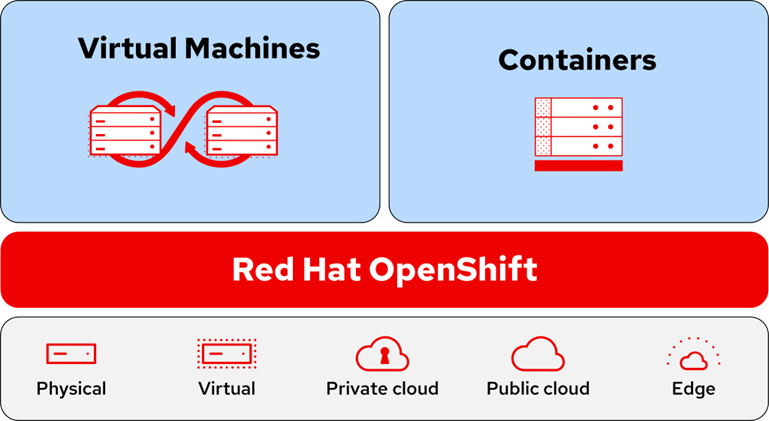Welcome to the first blog post of our blog series exploring the synergy between Red Hat OpenShift and Lightbits.
Today, we’re talking all about the seamless integration of Lightbits NVMe® over TCP persistent block storage with Red Hat OpenShift Virtualization and providing a glimpse into how scaling virtual machines (VMs) does not affect performance on the Lightbits storage. Next time, we’ll get into the nitty-gritty of performance, showing you just how well Lightbits scales with sustained low latency, even under load. Stay tuned to see how Lightbits can seriously improve performance, scalability, and durability in your Red Hat OpenShift environment.
In today’s cloud-native world, organizations are increasingly adopting containerized workloads and Kubernetes for scaling applications. Since the VMware acquisition by Broadcom, Red Hat OpenShift-V (OpenShift Virtualization) has become the preferred choice for managing virtualized environments within OpenShift.
Red Hat OpenShift-V is an OpenShift-based platform that brings virtualization capabilities to Kubernetes, allowing users to run virtual machines (VMs) alongside containers in a unified architecture. This combination of containers and VMs in a single platform simplifies application management, enabling hybrid workloads that can benefit from both container-native and virtualized environments. Figures 1 and 2 show a high-level overview of OpenShift and OpenShift-V.
One of the challenges in OpenShift-V is the need for high-performance, flexible, software-defined storage that can support the unique requirements of virtualized workloads, such as fast data access, persistence, consistent low latency, and scalability. Practical workloads that benefit from high-performance storage include database-intensive applications like SQL and NoSQL databases, big data analytics, machine learning training models, video rendering, and real-time data processing. This is where Lightbits shines.

OpenShift with OpenShift-V Landscape – Source: https://www.redhat.com/en/engage/application-modernisation/others

Figure 2: OpenShift Landscape – Source: https://docs.redhat.com/en/documentation/openshift_container_platform/4.7/html/about/oke-about
Lightbits Disaggregated Software-Defined Storage Overview
Lightbits represents a paradigm shift in how storage resources are managed and utilized in modern data centers. Lightbits’ unique disaggregated, software-defined, NVMe® over TCP, block storage architecture – combined with Intelligent Flash Management and enterprise-rich data services – makes it the only complete cloud data platform that’s easy to provision and simple to manage but also highly scalable, performant, and cost-efficient.
At its core, it leverages NVMe over TCP (NVMe/TCP) storage protocol technology, which was invented by Lightbits and then ratified and given to the open-source community, to deliver low-latency, high-performance block storage over a regular Ethernet network. This not only reduces the cost and complexity compared to other technologies like Fibre Channel or Infiniband but also democratizes access to high-speed NVMe storage.
The software-defined nature of Lightbits’ solution means it can be deployed on commodity servers and scaled across a distributed architecture without the need for specialized networking equipment or proprietary hardware. This flexibility combined with advanced features such as Intelligent Flash Management, ElasticRAID, in-line compression, thin provisioning, snapshots, and clones produces a solution that enhances data durability, optimizes storage efficiency, and reduces overall operating costs. Lightbits software can be used not only on-premises but also in public clouds like AWS, Azure and OCI.
Why Lightbits for OpenShift Virtualization Storage?
Although there are many solutions for OpenShift Virtualization storage today, not all of them are created equal. Most backend storage solutions provide enough performance for small to medium-sized applications that do not require high performance but do not have the necessary performance for all application workloads. In a large OpenShift deployment, organizations cannot afford to have application timeouts due to low throughput with high tail latency. Storage scalability is also a big concern. This is very crucial in an OpenShift deployment because the purpose of OpenShift is to provide vast amounts of virtual resources to many applications running in parallel. To meet these high SLA requirements, both OpenShift infrastructure and its storage solutions must have enough resources and the ability to scale to meet the demands of users.
Lightbits software-defined storage offers such a solution for OpenShift. Due to its unique architecture and features that directly address the core challenges of scalability, performance, and reliability, Lightbits offers a compelling backend storage solution for OpenShift. Below are some advantages of using Lightbits as backend storage for OpenShift:
- Disaggregation: enable large-scale storage clusters for OpenShift needing high performance block storage.
- Scalability, Simplicity, Flexibility & Agility: scale up by adding SSDs and scale out by adding nodes/clusters. Lightbits enables users to add NVMe devices to existing Lightbits servers with available drive slots or add more servers with NVMe devices to an existing cluster without downtime.
- High Performance: leverages NVMe/TCP to provide high IOPS/Throughput with consistent low average and tail latencies.
- Cloud-Native Compatibility: support for modern workloads that require agile and flexible storage solutions.
- Multi-Tenancy: provides tenant isolation when running on the same cluster.
- Data Durability: provides data durability that combines several key technologies such as data replication, erasure coding, cyclic redundancy checks, fine-grained failure-domains, snapshots (redirect on write) and clones.
Figure 3 below shows Lightbits as a backend storage solution for Red Hat OpenShift.

Figure 3: Lightbits for OpenShift
OpenShift with Lightbits Backend Storage
Like many other storage solutions, Lightbits also provides a dedicated CSI driver for OpenShift persistent block storage. This integration allows for easy management and provisioning of block storage across the OpenShift environment whether they are for containers or VMs. Integrating Lightbits with OpenShift is a straightforward process, thanks to Lightbits’ native support for Kubernetes and OpenShift. Here is how you can get started:
- Install Lightbits CSI Driver: The first step is to deploy the Lightbits Container Storage Interface (CSI) driver in your OpenShift cluster. This driver enables OpenShift-V to interact with the Lightbits storage backend, exposing storage volumes to VMs.
- Provision Storage Volumes: Once the CSI driver is installed, you can create persistent volume claims (PVCs) for your OpenShift-V workloads. These PVCs will provision storage volumes from Lightbits, ensuring that your VMs have the required storage capacity.
- Attach Storage to Virtual Machines: With storage volumes provisioned from Lightbits, you can attach them to your VMs running on OpenShift-V. This integration allows for seamless management of virtualized storage alongside containerized workloads.
- Ensure High Availability: By leveraging Lightbits’ built-in replication capabilities, your VMs can benefit from highly available, redundant storage. This is especially critical for production workloads that demand high uptime.
Key Benefits of Using Lightbits with OpenShift-V
- Performance: Lightbits is built to handle high-throughput and low-latency workloads, making it ideal for demanding VM applications in OpenShift-V. The ability to use NVMe storage directly also results in better performance, which is critical for virtualized environments.
- Flexibility: As a software-defined storage solution, Lightbits can be deployed across a variety of hardware configurations, giving you the flexibility to choose the best infrastructure for your organization. It can run on any standard x86 server, providing cost-efficient scaling.
- Cost Efficiency: Unlike traditional storage systems, Lightbits does not require dedicated hardware or proprietary devices. It makes use of commodity hardware, reducing CAPEX and offering better cost-per-TB when scaling storage capacity.
- Automation: The integration with OpenShift’s management layer means that storage provisioning, scaling, and management can be automated. This reduces the time spent on manual operations and improves overall efficiency in the data center.
To give you a clearer picture of how OpenShift-V integrates with Lightbits storage, below are a couple of screenshots from the OpenShift console. The first image shows the Persistent Volume Claims (PVCs) created for virtualized workloads, while the second image illustrates the VMs attached to these PVCs, showcasing the seamless integration between OpenShift-V and Lightbits storage.

Figure 4: Persistent Volume Claims (PVCs)

Figure 5: Virtual Machines (VMs)
To further illustrate the performance of Lightbits storage with OpenShift-V, below are screenshots of PuTTY sessions running FIO (Flexible I/O Tester) workloads on four VMs. These images show the disk performance metrics during the FIO benchmark tests. While the VMs scale out nicely across the worker node, providing solid performance, it’s important to note that the results here are influenced by the virtio layer in the OpenShift platform and the CPU limitations of the worker node. The worker node is equipped with a second-generation Intel Silver Cascade Lake processor, and all four VMs are running on the same node. As a result, each VM reaches approximately 20K IOPS at less than 400 microseconds, which highlights the performance constraints caused by the virtio layer and CPU, rather than any limitations of the Lightbits storage itself.

Figure 6: VM-1 running FIO

Figure 7: VM-2 running FIO

Figure 8: VM-3 running FIO

Figure 9: VM-4 running FIO
Conclusion
As enterprises continue to modernize their IT infrastructure and adopt both open-source containerization and virtualization solutions like OpenShift-V, the need for robust, flexible, and high-performance storage solutions grows. OpenShift-V offers an ideal platform for running virtualized workloads within a Kubernetes environment, and when combined with Lightbits software-defined storage, it provides a powerful solution for modern virtualized applications. The integration of Lightbits with OpenShift-V offers a compelling solution to meet the growing demands of virtualization, especially when organizations are moving away from other virtualized vendors and embrace the OpenShift platform. This solution also ensures scalability, performance, and reliability for hybrid workloads.
By using this combination, businesses can get the most out of both virtualized and containerized environments, making management simpler while ensuring a high-performing infrastructure that can handle a wide range of apps.

